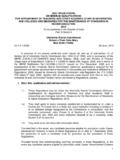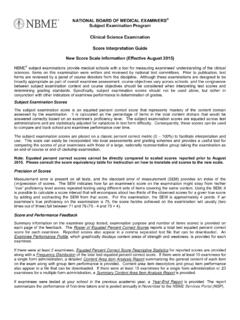Transcription of Updated WHO position paper on rabies vaccines
1 Updated WHO position paper on rabies vaccines . Published in WER on 6 august 2010 1 | Updated WHO position paper on rabies vaccines Geneva, Switzerland august 2010 Updated WHO position paper on rabies vaccines . Published in WER on 6 august 2010 2 | Introduction Replaces the position paper on rabies vaccines published in the Weekly Epidemiological Record in December 2007 august 2010 paper incorporates recent developments in the field of human rabies vaccines , in particular with regard to immunization schedules Footnotes provide a limited number of core references Additional document with a more comprehensive list of references available Grading tables that assess the quality of scientific evidence for key conclusions also available Updated WHO position paper on rabies vaccines . Published in WER on 6 august 2010 3 | Background information rabies is a viral zoonosis of mammals Rabid dogs are the dominant source of human infection Incubation period 1-3 months (<1 week to >1 year) In humans, the rabies virus causes acute invariably fatal encephalitis Each year, rabies causes an estimated 55 000 human deaths, many in children in rural Africa and Asia rabies may be grossly underreported; without post-exposure prophylaxis it is estimated that approximately 327 000 persons would die from rabies each year In industrialized countries and most urbanized areas of Latin America human (dog-mediated) rabies is nearly eliminated due to vaccination of domestic dogs and other control measures Updated WHO position paper on rabies vaccines .
2 Published in WER on 6 august 2010 4 | Cell-culture-based rabies vaccines (CCRVs) Most CCRVs are propagated in either human diploid cells ( embryonic fibroblast cells), fetal rhesus diploid cells, Vero cells ( kidney cells from African green monkey), primary Syrian hamster kidney cells, primary chick embryo cells, or in embryonated duck eggs CCRVs are safe and efficacious and have been administered to millions of people worldwide CCRVs can be administered intramuscularly (IM), but some are recommended also for vaccine -saving intradermal (ID) use Updated WHO position paper on rabies vaccines . Published in WER on 6 august 2010 5 | CCRV development Following growth in the respective cell cultures, the viral harvest is concentrated, purified, inactivated and lyophilized. Some CCRVs use human albumin or processed gelatine as stabilizer. No thimerosal is added to most CCVS Shelf-life: 3 years at +2 C to +8 C.
3 Storage in darkness Lyophilized CCRVs, once reconstituted with accompanying diluent, should be used immediately or within 6 8 hours CCRVs should comply with the WHO recommended potency of IU per single IM dose Updated WHO position paper on rabies vaccines . Published in WER on 6 august 2010 6 | Intradermal administration Compared with the standard IM use of CCRVs, ID administration is equally safe and immunogenic ID regimens require only 1 2 vials for post-exposure prophylaxis, reducing volume and direct costs by 60 80% The same vaccine potency ID is used for both IM and ID ID vaccines must be explicitly authorized for this route ID regimens require sufficient staff training to ensure correct storage, reconstitution, and injection ID regimens have been successfully introduced for post-exposure prophylaxis in India, the Philippines, Sri Lanka and Thailand Updated WHO position paper on rabies vaccines .
4 Published in WER on 6 august 2010 7 | Efficacy of CCRVs An appropriate CCRV-series induces adequate neutralizing antibody concentrations ( IU/mL) in almost all healthy persons and so far, nobody with this antibody level before exposure has developed rabies Prompt post-exposure vaccination combined with proper wound management and administration of rabies immunoglobulin is almost invariably effective in preventing rabies , even after high-risk exposure Delays in starting or failure to complete correct prophylaxis may result in death, particularly following bites in highly innervated regions, such as the head, neck or hands, or following multiple wounds Updated WHO position paper on rabies vaccines . Published in WER on 6 august 2010 8 | Duration of protection Long-lasting immunity against rabies depends on immunological memory, which can be demonstrated by a rapid (anamnestic) antibody response to a booster dose Anamnestic responses following booster doses have been observed even 21 years after primary vaccination Long-lasting immunity against rabies is achieved regardless of route of immunization (IM or ID) and follows pre-exposure as well as post-exposure immunization Due to the long duration of protection, regular booster doses of the vaccine are not recommended following a completed pre-exposure or post-exposure series except for certain groups at continual, frequent or increased risk (see slide 15) Updated WHO position paper on rabies vaccines .
5 Published in WER on 6 august 2010 9 | Adverse events/ vaccine safety In general, CCRVs are shown to be safe and well tolerated However, in 35 45% of vaccinees, transient erythema, pain and/or swelling may occur at the injection site (ID>IM). Also, mild systemic reactions (transient fever, headache, dizziness and gastrointestinal symptoms) are observed in 5 15% of vaccinees Serious adverse events, mainly of allergic or neurological nature, rarely occur For pre-exposure prophylaxis (PrEP), previous severe reaction to vaccine components is a contraindication to further use; another CCV must be used to complete the PrEP series As rabies is a lethal disease, no contraindications apply to post-exposure prophylaxis following high-risk exposure Updated WHO position paper on rabies vaccines . Published in WER on 6 august 2010 10 | rabies immunoglobulin rabies immunoglobulin should be administered in all people with category III* exposure and to those with category II* exposure who are immunodeficient Human rabies immunoglobulin (half-life is about 21 days) is the preferred product, but it is expensive and in short supply Equine immunoglobulin or its F(ab )2 products have a faster clearance, but are more widely available and considerably less expensive Although most new equine immunoglobulin preparations are potent, highly purified, and safe, they are of heterologous origin, and an anaphylactic reaction occurs in about 1/45 000 cases *risk categories presented later Updated WHO position paper on rabies vaccines .
6 Published in WER on 6 august 2010 11 | Economic considerations It is estimated that in Africa and Asia, deaths due to rabies could be responsible for million disability-adjusted life years (DALYs) lost each year The annual cost of rabies , including costs for post-exposure prophylaxis and rabies control in dogs, has been calculated at US$ million In 2005, the estimated global expenditure for rabies prevention exceeded US$ 1 billion The frequency and costs of post-exposure prophylaxis are expected to rise dramatically in all countries where rabies is present in dogs, particularly where nerve-tissue vaccines are replaced by CCVs Updated WHO position paper on rabies vaccines . Published in WER on 6 august 2010 12 | WHO position on the use of rabies vaccines (1) Nerve tissue vaccines Production and use of nerve-tissue vaccines should be discontinued as soon as possible and replaced with CCVs ID administration of CCVs CCVs for ID use should meet the same WHO requirements for production and control as for vaccines for IM administration only The immunogenicity and safety of vaccines for ID regimens should be demonstrated in appropriate clinical trials To be endorsed, new ID post-exposure regimens must have clear practical or economical advantages over existing IM regimens In countries where ID administration is approved for post-exposure prophylaxis, manufacturers of vaccines proved to be safe and efficacious by this route should clearly state that their vaccine can be used intradermally Updated WHO position paper on rabies vaccines .
7 Published in WER on 6 august 2010 13 | WHO position on the use of rabies vaccines (2) Pre-exposure prophylaxis (PrEP) PrEP is recommended for anyone at continual, frequent or increased risk of exposure to the rabies virus, either as a result of residence or occupation Travellers with extensive outdoor exposure in rural high-risk areas with limited access to appropriate medical care should also be vaccinated, regardless of duration of stay Children living in, or visiting, rabies -affected areas are at increased risk WHO encourages the implementation of carefully designed studies on the feasibility, cost-effectiveness and long-term impact of incorporating CCVs into the immunization programmes of infants and children Updated WHO position paper on rabies vaccines . Published in WER on 6 august 2010 14 | WHO position on the use of rabies vaccines (3) Administration of PrEP IM administration requires doses of 1 ml or ml (volume depending on type of vaccine ) given on days 0, 7 and 21 or 28 For adults and children 2 years the IM vaccine is injected in the deltoid area of the arm; for children <2 years in the antero-lateral thigh.
8 IM vaccines should not be given in the gluteal area ID administration of ml on days 0, 7, and 21 or 28 is an acceptable alternative to the standard IM route To lead to significant savings, ID sessions should involve enough individuals to utilize all opened vials within 6 8 hours Updated WHO position paper on rabies vaccines . Published in WER on 6 august 2010 15 | WHO position on the use of rabies vaccines (4) Booster injections of rabies vaccine Periodic booster doses are not required for individuals who have received a complete primary series of pre- or post-exposure prophylaxis with a CCV Periodic booster injections are recommended as an extra precaution only for people whose occupation puts them at continual, frequent or increased risk of exposure ( some laboratory workers and veterinarians) If available, antibody monitoring of personnel at risk is preferred to the administration of periodic boosters.
9 Antibody testing should be done every 6 -24 months, depending on the risk assessment. A booster would be recommended only if rabies virus neutralizing antibody titres fall to < IU/ml. Updated WHO position paper on rabies vaccines . Published in WER on 6 august 2010 16 | WHO position on the use of rabies vaccines (5) Post-exposure prophylaxis (PEP) The indication for PEP depends on the type of contact with the suspected rabid animal: category I touching or feeding animals, licks on intact skin category II nibbling of uncovered skin, minor scratches or abrasions without bleeding category III single or multiple transdermal bites or scratches, contamination of mucous membrane with saliva from licks, licks on broken skin, exposures to bats If possible, the rabies suspected animal should be kept under observation for at least 10 days, or be killed to obtain specimens for appropriate laboratory examination Updated WHO position paper on rabies vaccines .
10 Published in WER on 6 august 2010 17 | WHO position on rabies vaccines (6) Post-exposure prophylaxis (PEP) contd. Category I exposures, no prophylaxis is required Category II, immediate vaccination Category III, immediate vaccination and administration of rabies immunoglobulin For categories II and III, thorough washing of all bite wounds and scratches should be done as early as possible Where available, an iodine-containing, or similarly viricidal, topical preparation should be applied to the wound When impossible to complete PEP with the same CCV, another CCV should be used Updated WHO position paper on rabies vaccines . Published in WER on 6 august 2010 18 | WHO position on rabies vaccines (7) PEP for category II and III exposures IM administration requires 1 ml or ml (depending on type of vaccine ) into the deltoid muscle (or anterolateral thigh in children aged <2 years) (i) the 5-dose regimen prescribes 1 dose on each of days 0, 3, 7, 14 and 28 (ii) the 4-dose regimen prescribes 2 doses on day 0 (1 in each of the 2 deltoid or thigh sites) followed by 1 dose on each of days 7 and 21 An alternative regimen for healthy, fully immunocompetent people who receive wound care plus high quality rabies immunoglobulin (RIG) plus WHO-prequalified rabies vaccines is 4 doses administered IM on days 0, 3, 7 and 14 Updated WHO position paper on rabies vaccines .















